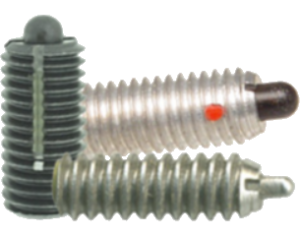
Indexing plungers come in a variety of styles, one of the most popular being ball. Ball plungers feature a spring-enclosed shaft and a ball. They are used for indexing and positioning applications. If you need to index or position a component, you may want to use a ball plunger.
Overview of Ball Plungers
Ball plungers are indexing plungers with a shallow ball at the top. They feature a spring inside of a shaft. The shaft has exterior threading on the sides and a drive recess on the bottom, thus allowing it to be driven into components and workpieces. At the top of a ball plunger is a shallow ball.
When exposed to a force, the ball will recede into the ball plunger’s shaft. The shaft contains a simple compression spring. Therefore, the spring will compress while becoming shorter, and the ball will recede into the shaft. Once the force has been removed, the spring will revert back to its original size and shape while pushing the ball back out of the shaft.
How Ball Plungers Differ From Other Types of Plungers
There are other types of plungers, many of which feature a similar design as ball plungers. Spring plungers, for instance, consist of a spring-enclosed shaft with exterior threading — just like ball plungers. They are also used for many of the same indexing and positioning applications.
Spring plungers, however, don’t have a ball. Instead, they feature a nose. The nose on spring plungers is longer and narrower than the ball on ball plungers. With a long nose, spring plungers support lateral movement. Force applied from the side will compress the nose on a spring plunger.
When to Use Ball Plungers
You can use ball plungers for indexing and positioning applications involving light loads. They are simple, inexpensive and easy to use. Ball plungers have a drive recess on the bottom, such as a slotted drive recess. To install them, you can use a screwdriver with the appropriate bit.
For indexing and positioning applications involving heavy loads, though, you may want to use spring plungers. Spring plungers can handle heavier loads. Ball plungers are designed for light loads.
Spring plungers are designed exclusively for use in applications in which a force is applied from the top. The ball won’t move when a force is applied from the side. If you’re looking for plungers to use in applications involving a side force, you may want to choose spring plungers, instead. Ball plungers can handle forces applied from the top and side.
